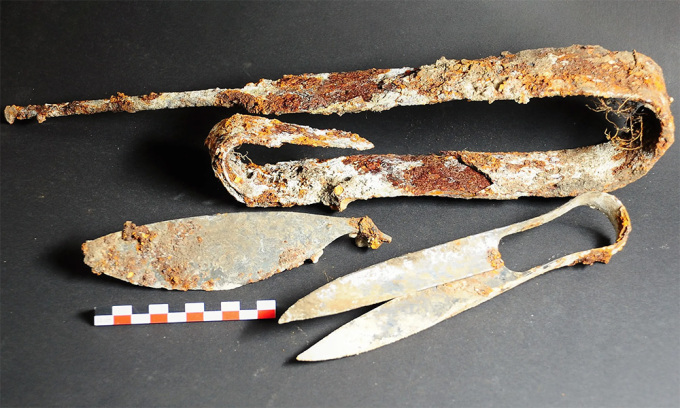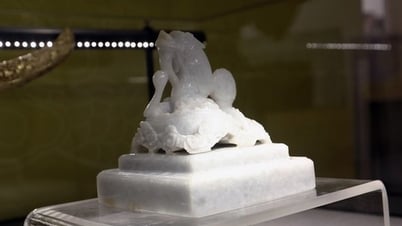Ancient scissors found in a Celtic grave were so well preserved that parts of them were still shiny and could be used for cutting.

Objects found in the Celtic grave at Sendling, including a pair of still-sharp scissors. Photo: Maximillian Bauer/BLfD
An explosive ordnance disposal team was searching a construction site in Sendling, a suburb of Munich, for unexploded World War II bombs when they stumbled upon a buried wooden structure, IFL Science reported on May 3. It was actually a Celtic cremation tomb dating back to the 2nd or 3rd century BC.
The team then invited a team of archaeologists from the Bavarian State Office for Monuments Conservation (BLfD) to investigate. They found a series of ancient artifacts including a bent sword, the remains of a shield and spear, a razor and a pin. Among them was a pair of 2,300-year-old scissors, so well preserved that they looked almost new, slightly shiny and still usable. Dr. Mathias Pfeil of BLfD said that the scissors' still-shiny appearance was due to the high level of craftsmanship.
While it is unclear exactly why scissors were buried in Celtic graves, scientists believe they may have had both practical and symbolic significance for the deceased.
Scissors were important tools for the Celts, used for cutting hair, wool, and other materials. It is therefore possible that they were buried in graves as a symbol of the deceased’s craft or trade. However, in ancient mythology, especially Celtic stories, scissors were often associated with goddesses associated with spinning and weaving – activities that were important in Celtic culture. It is therefore possible that the scissors were also buried to be used as a practical tool in the afterlife .
BLfD concluded that from the 3rd to 2nd centuries BC, the Celts cremated their dead and buried their ashes in pits. Valuable burial objects were then buried with them so that the deceased could use them in the afterlife. The newly discovered tomb also helped scientists determine that the deceased in this burial site had a high social status.
Thu Thao (According to IFL Science )
Source link




![[Photo] Vietnamese and Hungarian leaders attend the opening of the exhibition by photographer Bozoky Dezso](https://vphoto.vietnam.vn/thumb/1200x675/vietnam/resource/IMAGE/2025/5/29/94d8ceca5db14af3bf31285551ae4bb3)

![[Photo] Prime Minister Pham Minh Chinh meets with Hungarian President Sulyok Tamas](https://vphoto.vietnam.vn/thumb/1200x675/vietnam/resource/IMAGE/2025/5/29/dbcaa73e92ea4448a03fe1d0de6d68e8)























































































Comment (0)